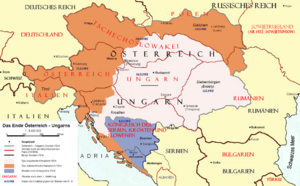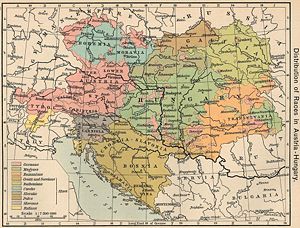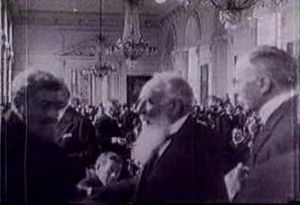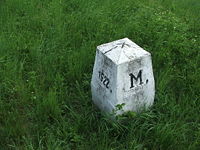Treaty of Trianon
The Treaty of Trianon is the peace treaty concluded at the end of World War I by the Allies of World War I, on one side, and Hungary, seen as a successor of Austria-Hungary, on the other. It established the borders of Hungary and regulated its international situation. Hungary lost over two-thirds of its territory and about two-thirds of its inhabitants under the treaty. The principal beneficiaries of territorial adjustment were Romania, Czechoslovakia, and the Kingdom of Serbs, Croats, and Slovenes. The treaty was signed on June 4, 1920, at the Grand Trianon Palace in Versailles, France. Officially, the treaty was intended to be a confirmation of the concept of the right for self-determination of nations and of the concept of nation-states replacing old multinational empires. Most non-Hungarians that lived in the former Kingdom of Hungary, after centuries of foreign rule and most of the peoples of former Austria-Hungary (often called a "dungeon of nations" by them) would finally achieve a right for self-determination and independence, and be united with other members of their nation. Over the previous 50 years, the Balkan nations had won their independence from the declining Ottoman Empire; now the victorious Allies saw their task as completing that same process further north following the dissolution of the Habsbirg Empire. On the other hand, Hungarians (and some non-Hungarian historians as well) claim that the real motive of the treaty was simply an attempt to dismantle a major power in Central Europe. The Western powers' main priority was to prevent a resurgence of Germany and they therefore decided that her allies in the region, Austria and Hungary, should be "contained" by a ring of states friendly to the Allies, each of which would be bigger than either Austria or Hungary. Like most of the measures implemented by the victors of World War I to contain Germany, the Treaty backfired because it contributed to Germany's sense of being besieged, and to German determination to throw off such shackles and to strike back.
Frontiers of Hungary
The Hungarian government terminated the personal union with Austria on October 31, 1918, officially dissolving the Austro-Hungarian state. The de facto temporary borders of independent Hungary were defined by the ceasefire lines in November-December 1918. Compared with the former Kingdom of Hungary, these temporary borders did not include:
- Part of Transylvania south of the Mureş river and east of the Someş river, which came under the control of Romania (Ceasefire agreement of Belgrade signed on November 13, 1918). On December 1, 1918, the National Assembly of Romanians in Transylvania declared the union with the Kingdom of Romania.
- The Kingdom of Croatia-Slavonia crownland, which formed first a State of Slovenes, Croats and Serbs with other South Slavic ex-Austro-Hungarian territories on October 1, 1918, then the Kingdom of Serbs, Croats and Slovenes by joining also with the Kingdom of Serbia on December 1, 1918.
- Most of the Baranya, Bács-Bodrog, Torontál, Temes and Krassó-Szörény counties according to the ceasefire agreement of Belgrade signed on November 13, 1918. The Great People's Assembly of Serbs, Croats, Bunyevs, Slovaks, Rusyns and other peoples from Banat, Bačka and Baranja declared union with the Kingdom of Serbia on November 25, 1918. The ceasefire line had a character of temporary international border until the treaty. On December 1, 1918, the National Assembly of Romanians in Banat voted union with the Kingdom of Romania
- Slovakia, which became part of Czechoslovakia (status quo set by the Czechoslovak legions and accepted by the Entente on November 25, 1918).
- The city of Fiume (Rijeka), which joined the State of Slovenes, Croats and Serbs, but was subsequently occupied by the Italian Army and became a matter of international dispute between the Kingdom of Italy and the Kingdom of Serbs, Croats and Slovenes.
After the Romanian Army advanced beyond this ceasefire line, the Entente powers asked Hungary (Vix note) to acknowledge the new Romanian territory gains by a new line set along the Tisza river. Unable to reject these terms and unwilling to accept them, the leaders of the First Hungarian Republic resigned and the communists seized power. The Hungarian Soviet Republic was formed and a new Hungarian Red Army was rapidly set up. This army was initially successful against the Czechoslovak Legions (see Slovak Soviet Republic) and made it possible for Hungary to reach nearly the former Galitian (Polish) border, thus separating the Czechoslovak and Romanian troops from each other.
After a Hungarian-Czechoslovak ceasefire signed on July 1, 1919, the Hungarian Red Army left Slovakia by July 4, as the Entente powers promised Hungary to invite a Hungarian delegation to the Versailles Peace Conference. However, instead of an invitation to the peace talks, the Romanian army attacked at the Tisza river on July 20, 1919 and the Hungarian Red Army rapidly collapsed. The Royal Romanian Army marched into Budapest on August 4, 1919.
The Hungarian state was restored by the Entente powers, helping Admiral Horthy into power in November 1919. On December 1, 1919 the Hungarian delegation was officially invited to the Versailles Peace Conference, however the new borders of Hungary were nearly finalized without the presence of the Hungarians.
The final borders of Hungary were defined by the Treaty of Trianon signed on June 4, 1920. Beside the previously mentioned territories, they did not include:
- the rest of Transylvania together with former Eastern Hungary, which became part of Romania;
- Carpathian Ruthenia, which became part of Czechoslovakia, pursuant to the Treaty of Saint-Germain in 1919;
- most of Burgenland, which became part of Austria, also pursuant to the Treaty of Saint-Germain; the district of Sopron opted to remain with Hungary after a plebiscite held in December 1921 (it was the only place where a plebiscite was permitted in the decision);
- Međimurje and Prekmurje, which became part of the Kingdom of Serbs, Croats and Slovenes.
By the Treaty of Trianon, the cities of Pécs, Mohács, Baja and Szigetvár, which were under Yugoslav administration after November 1918, were assigned to Hungary.
An arbitration committee in 1920 assigned small northern parts of the former Árva and Szepes counties of the Kingdom of Hungary with Polish majority population to Poland.
Compared with the former Kingdom of Hungary, the population of post-Trianon Hungary was reduced from 20.8 million to 7 million and its land area decreased by 72 percent.
After 1918, Hungary did not have access to the sea, which it had had directly through the Rijeka coastline and indirectly through the Kingdom of Croatia-Slavonia.
With the help of Nazi Germany and Italy, Hungary expanded its borders towards neighboring countries at the outset of World War II, under the Munich Agreement (1938), the two Vienna Awards (1938 and 1940), following the dissolution of Czechoslovakia (occupation of northern Carpathian Ruthenia and eastern Slovakia) and following German aggression against Yugoslavia. This territorial expansion was short-lived, since the post-war boundaries agreed on at the Treaty of Paris in 1947 were nearly identical to those of 1920 (with three villages—Jarovce, Rusovce, and Čunovo—transferred to Czechoslovakia).
Aftermath
Demographic consequences


According to the census of 1910, the largest ethnic group in the Kingdom of Hungary were the Magyars (usually called "Hungarians" in English), who were approximately 48 percent of the entire population (or 54 percent of the population of the territory referred to as "Hungary proper," i.e., excluding Croatia-Slavonia). The Kingdom of Hungary was not a nation-state as were many Western European nations.
Some demographers believe that the 1910 census overstated the percentage of the Magyar population, arguing that there were different results in previous censuses of the Kingdom and subsequent censuses in the new states. Another problem with interpreting the census results is that the 1910 census did not record the respondents' ethnicity, but only language (whether it was "native language" or "most frequently spoken language") and the religion, thus the presented census numbers of ethnic groups in the Kingdom of Hungary are actually the numbers of speakers of various languages, which may not correspond exactly to the ethnic composition.
Although the territories of the former Kingdom of Hungary that were assigned by the treaty to neighboring states had a majority of non-Magyar population, they also included significant Magyar minorities, numbering 3,318,000 in total, distributed as follows:
The number of Hungarians in the different areas based on census data of 1910.
- In Slovakia: 885,000—30 percent
- In Transylvania (Romania): 1,662,000—32 percent
- In Vojvodina (Serbia): 420,000 - 28 percent
- In Transcarpathia (Ukraine): 183,000—30 percent
- In Croatia: 121,000—3.5 percent
- In Slovenia: 20,800—1.6 percent
- In Burgenland (Austria): 26,200—9 percent
Population of mentioned territories based on census data of 1910:
- In Slovakia (Czechoslovakia): 1,687,977 Slovaks and 1,233,454 others (mostly Hungarians—886,044, Germans, Ruthenians and Roma) [according to the 1921 census, however, there were 1,941,942 Slovaks and 1,058,928 others]
- In Carpathian Ruthenia (Czechoslovakia): 330,010 Ruthenians and 275,932 others (mostly Hungarians, Germans, Romanians, and Slovaks)
- In Transylvania (Romania): 2,829,454 Romanians and 2,428,013 others (mostly Hungarians and Germans)
- In Vojvodina and Croatia-Slavonia (Yugoslavia): 2,756,000 Serbo-Croatians and 1,366,000 others (mostly Hungarians and Germans)
- In Burgenland (Austria): 217,072 Germans and 69,858 others (mainly Croatian and Hungarian)
Minorities in post-Trianon Hungary
On the other hand, a considerable number of other nationalities remained within the frontiers of the new Hungary:
According to the 1920 census 10.4 percent of the population spoke one of the minority languages as mother language:
- 551,211 German (6.9 percent)
- 141,882 Slovak (1.8 percent)
- 23,760 Romanian (0.3 percent)
- 36,858 Croatian (0.5 percent)
- 17,131 Serb (0.2 percent)
- 23,228 other Southern Slavic dialects, mainly Bunjevac and Šokac (0.3 percent) and some 7,000 Slovenes
The number of bilingual people was much higher, for example 1,398,729 people spoke German (17 percent), 399,176 people spoke Slovak (5 percent), 179,928 people spoke Serbo-Croatian (2.2 percent) and 88,828 people spoke Romanian (1.1 percent). Magyar was spoken by 96 percent of the total population and was the mother language of 89 percent.
The percentage and the absolute number of all non-Magyar nationalities decreased in the next decades, although the total population of the country increased. Bilingualism was also disappearing. The main reasons of this process were spontaneous assimilation and the Magyarization policy of the state. Minorities made up 8 percent of the total population in 1930 and 7 percent in 1941 (on the post-Trianon territory).
After WWII about 200,000 Germans were deported to Germany according to the decree of the Potsdam Conference. Under the forced exchange of population between Czechoslovakia and Hungary, approximately 73,000 Slovaks left Hungary. After these population movements Hungary became an ethnically almost homogeneous country except the rapidly growing number of Roma people in the second half of the twentieth century.
Political consequences
Officially, the treaty was intended to be a confirmation of the concept of the right for self-determination of nations and of the concept of nation-states replacing old multinational empires.
From the point of view of most non-Hungarians that lived in the former Kingdom of Hungary, after centuries of foreign rule, most of the peoples of former Austria-Hungary (often called a "dungeon of nations" by them) would finally achieve a right for self-determination and independence, and be united with other members of their nation. Over the previous 50 years, the Balkan nations had won their independence from the declining Ottoman Empire; now the victorious Allies saw their task as completing that same process further north following the dissolution of the Habsburg Empire.
On the other hand, Hungarians (and some non-Hungarian historians as well) claim that the real motive of the treaty was simply an attempt to dismantle a major power in Central Europe. The Western powers' main priority was to prevent a resurgence of Germany and they therefore decided that her allies in the region, Austria and Hungary, should be "contained" by a ring of states friendly to the Allies, each of which would be bigger than either Austria or Hungary (Macmillan 2003; Bethlen 1971, 89). Compared with the Habsburg Kingdom of Hungary, post-Trianon Hungary had 60 percent less population and its role in the region significantly weakened.
Many cities and regions that were ethnically diverse in the nineteenth century became for the most part monoglot (unilingual), or dominated by a single language and culture.
The Treaty and its consequences are debated in Central European politics to this day. The main controversy about the Treaty of Trianon concerns the borders of Hungary. While the majority of the areas that had been part of the Kingdom of Hungary but were not part of the independent country after the Treaty were inhabited by non-Hungarian nationalities, there were also many areas inhabited mainly by Hungarians which were not located within the borders of Hungary after the Treaty, and there have periodically been concerns about the treatment of these ethnic Hungarian communities in the neighboring states (Human Rights Watch; Duray 1997; FigyelőNet; Index). Areas with significant Hungarian populations include the Székelyföld in north-eastern Transylvania and some areas along the new Romanian-Hungarian border, southern parts of Slovakia (see: Komárno), southern parts of Carpatho-Ukraine, northern parts of Vojvodina (see: Ethnic groups of Vojvodina), etc.
The Western powers were aware of the problem posed by the presence of so many Hungarians (and Germans) living outside the core areas of the "new" nation-states of Hungary and Austria, although they assumed that the problem would solve itself over time as they expected that those ethnic Hungarians who were unhappy would gradually sell up and go to live in Hungary, which did not turn out to be the case. The Romanian delegation to Versailles feared in 1919 that the Allies were beginning to favor the partition of Transylvania along ethnic lines in order to reduce the potential exodus and Prime Minister Ion Bratianu even summoned British-born Queen Marie to France to strengthen their case. The Romanians argued that they had suffered a higher casualty rate in the war than either Britain or France and that the Western powers had a moral debt to repay. Ethnically diverse Transylvania should therefore be assigned to Romania. In the end the Romanian view prevailed and the option of partition was rejected. Transylvania was treated as a single entity which, because it had a Romanian majority overall, was assigned in entirety to Romania. Furthermore the Allies rejected the idea of plebiscites in any of the disputed areas with the exception of the city of Sopron, which voted to remain in Hungary (the Allies were indifferent as to the exact line of the new border between Austria and Hungary).
The victorious Allies arrived in France with a black-and-white view of the situation in central Europe which made the outcome inevitable. At the heart of the dispute lay fundamentally different views of the nature of the Hungarian presence in the disputed territories. For the Hungarians the whole of the Carpathian Basin was seen as "home" (including its parts mainly inhabited by non-Hungarians who saw this area as their own "home" as well). The western powers and the American press in particular (as well as most non-Hungarians that lived in the Carpathian Basin) saw the Hungarians as colonial-style rulers who had oppressed the Slavs and Romanians since 1867. There was therefore no difference between the Turks giving up Wallachia or Serbia in the late nineteenth century and Hungarians giving up Transylvania or Ruthenia (Gelardi 2006). For President Wilson (and for most non-Hungarians from the Carpathian Basin) it was a process of decolonization rather than a punitive dismemberment (as Hungarians saw it) (Gelardi 2006). British Prime Minister David Lloyd-George was in favor of Irish independence from Britain and saw the claims of the "subject peoples" of the former Habsburg Empire in the same light. The French naturally sided with their "Latin brothers," the Romanians, although Clemenceau personally detested Bratianu (Gelardi 2006).
Opposite to the opinion of most non-Hungarians from the Carpathian Basin, the Hungarians did not regard the outer parts of the former Kingdom of Hungary as colonial territories. For Hungarian public opinion the realization that the Americans, British and French were all convinced that at least half of the Carpathian Basin rightfully belonged to the Slavs and Romanians was profoundly shocking. Hungarians also considered the accusations as hypocrite, which also contributed to a sense of injustice. Incredulity was followed by a lingering bitterness. The perceived humiliation of the treaty became a dominant theme in inter-war Hungarian politics, analogous with the German reaction to the Treaty of Versailles. All official flags in Hungary were lowered until 1938 when they were raised by one third after southern Slovakia was "recovered" following the Munich Conference. For Hungarian pupils in the 1930s each school-day began with a prayer calling for the reversal of the treaty.
Other consequences
Economically, 61 percent of arable land, 88 percent of timber, 62 percent of railroads, 64 percent of hard surface roads, 83 percent of pig iron output, 55 percent of industrial plants and 67 percent of credit and banking institutions of the former Kingdom of Hungary lay within the territory of Hungary's neighbors. Romania, Yugoslavia, and Czechoslovakia had to assume part of the financial obligations of the former Kingdom of Hungary on account of the parts of its territory under their sovereignty.
Military considerations diverted the Treaty from the Wilson principles,[1] making economic cooperation within the Carpathian Basin more difficult. The borders bisected transport links—in the Kingdom of Hungary the road and railway network had a radial structure, with Budapest in the center. Many roads and railways running along the new borders and interlinking radial transport lines lay within the territory of Hungary's neighbors.
The military conditions were similar to those imposed on Germany by the Treaty of Versailles; the Hungarian army was to be restricted to 35,000 men and there was to be no conscription. Further provisions stated that in Hungary, no railway would be built with more than one track.
Hungary also renounced all privileges in territories outside Europe that belonged to the former Austro-Hungarian monarchy.
Articles 54–60 of the Treaty required Hungary to recognize various rights of national minorities within its borders.
See also
Notes
- ↑ Twenty-Five Lectures on Modern Balkan History, Steven W. Sowards, 2006. Retrieved November 25, 2007.
ReferencesISBN links support NWE through referral fees
- Bethlen, István. The Treaty of Trianon and European Peace. North Stratford, NH: Ayer Publishing,[1934] 1971.
- Duray, Miklos. The Hungarian Nationality in Slovakia. (Merano, 1997 Apr.) Retrieved November 7, 2007.
- FigyelőNet. Magyarverés Szlovákiában. Magyarverés Szlovákiában Retrieved November 7, 2007.
- Gelardi, Julia P. Born to Rule: Five Reigning Consorts, Granddaughters of Queen Victoria. St. Martin's Griffin, 2006. ISBN 0312324243
- Human Rights Watch. Assaults on Minorities in Vojvodina. Assaults on Minorities in Vojvodina Retrieved November 7, 2007.
- Index. Újabb magyarverés Újvidéken. Újabb magyarverés Újvidéken Retrieved November 7, 2007.
- Juhász, Gyula. Magyarország Külpolitikája 1919-1945. Budapest: Kossuth Könyvkiado, 1969; 1988 ISBN 9789630931038
- Kollányi, Vitéz Károly. Kárpáti trilógia. Budapest: Kráter Műhely Egyesület, 2002 ISBN 9789637329562
- Kovacsics, József. Magyarország történeti demográfiája : Magyarország népessége a honfoglalástól 1949-ig, Budapest: Közgazd. és Jogi Kiadó, 1963.
- Lajos, Thirring. Az 1869-1980. évi népszámlálások története és jellemzői [kész. a Központi Statisztikai Hivatal Népesedésstatisztikai Főosztályán]. Budapest: SKV, 1983.
- Macartney, Carlile Aylmer. October Fifteenth - A History of Modern Hungary 1929-1945. Edinburgh: Edinburgh University Press, 1956.
- Macmillan, Margaret. Paris 1919: Six Months that Changed the World. New York: Random House, 2003 ISBN 9780375508264
- Raffay, Ernő. Magyar tragédia: Trianon 75 éve. Budapest: Püski kiadó, 1996 ISBN 9789638256782
- Rockwell, Ernest A. Trianon Politics, 1994-1995. Thesis, Central Missouri State University, 1995.
External links
All links retrieved December 16, 2015.
- Map of Hungarian borders in November-December 1918
- Links related to Treaty of Trianon (in Hungarian)
- Murray N. Rothbard: But what about the Hungarians?
Credits
New World Encyclopedia writers and editors rewrote and completed the Wikipedia article in accordance with New World Encyclopedia standards. This article abides by terms of the Creative Commons CC-by-sa 3.0 License (CC-by-sa), which may be used and disseminated with proper attribution. Credit is due under the terms of this license that can reference both the New World Encyclopedia contributors and the selfless volunteer contributors of the Wikimedia Foundation. To cite this article click here for a list of acceptable citing formats.The history of earlier contributions by wikipedians is accessible to researchers here:
The history of this article since it was imported to New World Encyclopedia:
Note: Some restrictions may apply to use of individual images which are separately licensed.


